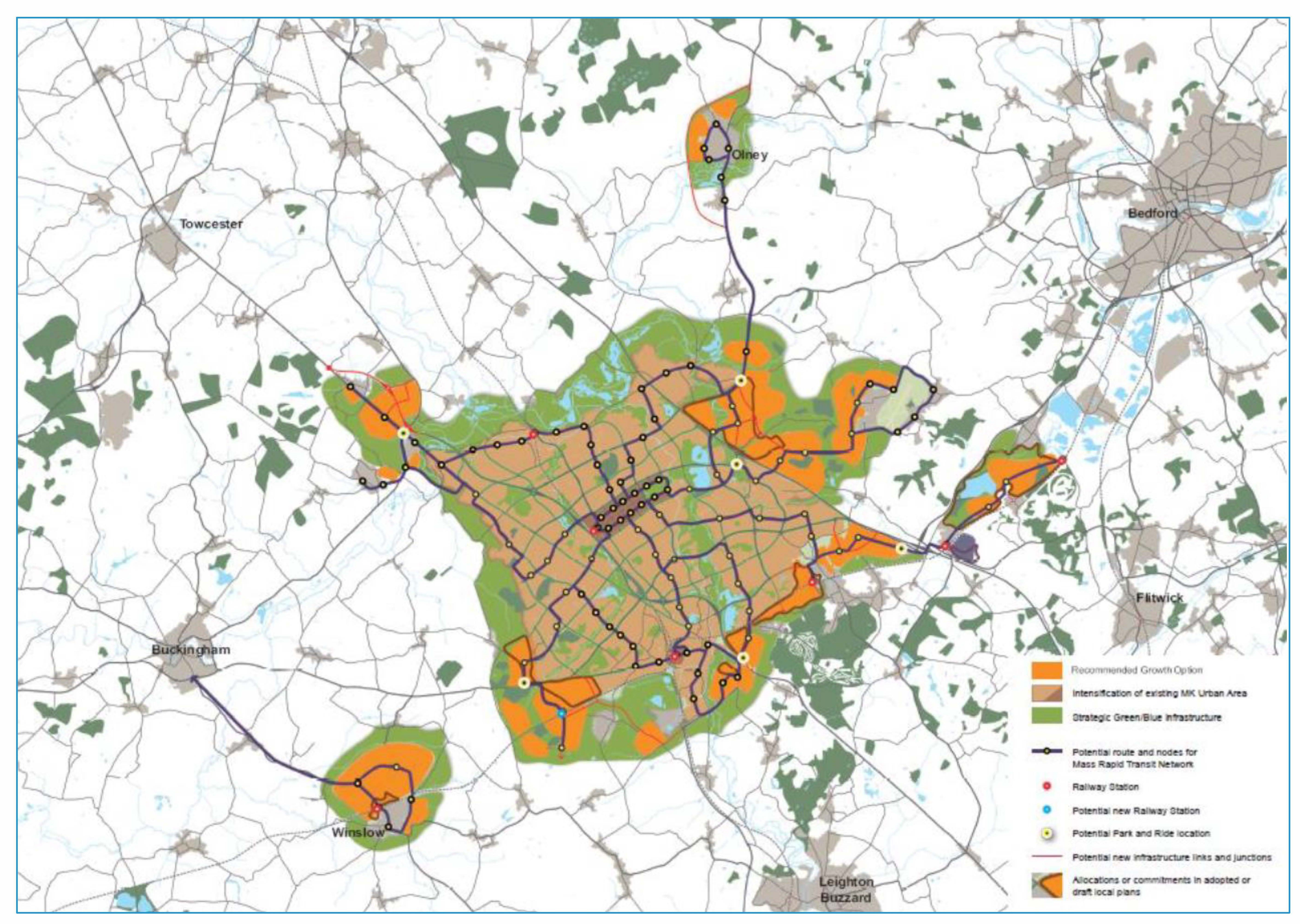Milton Keynes Futures Strategy 2050 - Planning for growth
It’s an exciting time for Milton Keynes. Plans for a new university, incoming significant investment , positive steps in the regeneration of the Lakes Estate and Fullers Slade and -arguably most importantly, the publication of the MK Futures Growth Strategy by Milton Keynes Council (MKC). Mark Harris explains what's next for the growth of Milton Keynes.

The ongoing MK Futures Consultation invites thoughts on a proposed ‘boundary blind’ strategy for the growth of MK up to 2050, when the population is planned to have grown to 500,000.
Growth focused around the grid system expansion and new transit-orientated communities is proposed alongside intensification within the city. In total, the strategy sets out how an additional 46,000 homes could be delivered in ‘Metropolitan’ Milton Keynes by 2050.

Figure 13: Recommended Spatial Strategy | Milton Keynes Future Strategy 2050
What is the strategy setting out to do?
Supported by a raft of evidence, the strategy sets out ambitious plans for reimagining how Milton Keynes could build on the original plan for the city. It looks to deal with emerging challenges in the city including a lack of access to public transport, deprivation, imbalance of jobs and homes, a growing carbon footprint and lack of vitality in the centre.
The strategy also seeks to build on the strengths and successes of the city including its green character, the road and rail networks and the potential flexibility built into the original plan for the city.
Publication of the Futures Strategy is a very positive step by MKC, taking the initiative at the start of what is likely to be a challenging time for the authority and surrounding area. At the heart of the Oxford-Cambridge Arc, the pressure for new homes and employment floorspace will be significant. There will not only be pressure for Milton Keynes to meet its own growth needs but it is likely that its neighbours will also look to areas around Milton Keynes to meet their future housing needs.
MKC is taking the lead and trying to shape growth near its boundaries. This is particularly important given the fallout from the ongoing Aylesbury Vale Local Plan examination and the proposed allocation of around 3,000 homes on the edge of Milton Keynes.
Over the next 12-18 months, the preparation of the West Northants Local Plan review, a likely strategic plan for Buckinghamshire, and any review of the Central Bedfordshire Local Plan, should this pass examination later this year, will potentially look towards the edge of Milton Keynes as a sustainable location to accommodate growth – and MKC appears to be ready for this with a positive strategy which looks to embrace and shape the expected growth in the area to deliver real benefit for the city, not just the development of homes and work places.
Delivering the strategy
Taking forward the planning and delivery of this ground-breaking strategy for growth is key. The planning will necessitate close and ongoing co-operation between the authorities. Would a joint plan(s) be a good idea?. It remains to be seen if this is this likely to happen but the early signs are not good and the lack of joined up thinking and working to a common goal would be a real threat to realising the benefits of growth in the area.
Delivering the strategy, particularly the rapid transit system, is likely to be challenging. It will require significant upfront investment. Will there be a role for government in supporting growth? Will there be an opportunity for a tariff style approach to forward fund infrastructure? Is there a role for capital markets to invest? These questions need answering, which may necessitate amendments to legislation such as CIL if they are to be feasible.
The government’s announcement that it intends to work to create a long-term Spatial Framework, may be the first positive step towards helping deliver MKC’s aspirations. Alongside this, confirmation that work on the M40/M1 expressway will be paused in favour of focusing on alleviating congestion around the Arc’s major economic centres, may also help MKC start to address issues identified in the Growth Strategy.
Bidwells' view
It is clear that the key to delivering such an ambitious strategy will be governance and conquering the political barriers that will influence the process moving forward. Will elected members embrace growth or will political division continue to impede delivery? Once a plan is in place, will MKC work with the development industry to expediate delivery?
There are many unanswered questions but what is not in question is that MKC has taken the first step in seeking to deliver a positive, sustainable future for Milton Keynes by seeking to control its own destiny.
It remains to be seen if this ambition can be turned into reality through collaboration with neighbouring authorities and the development industry, all built upon strong governance.

